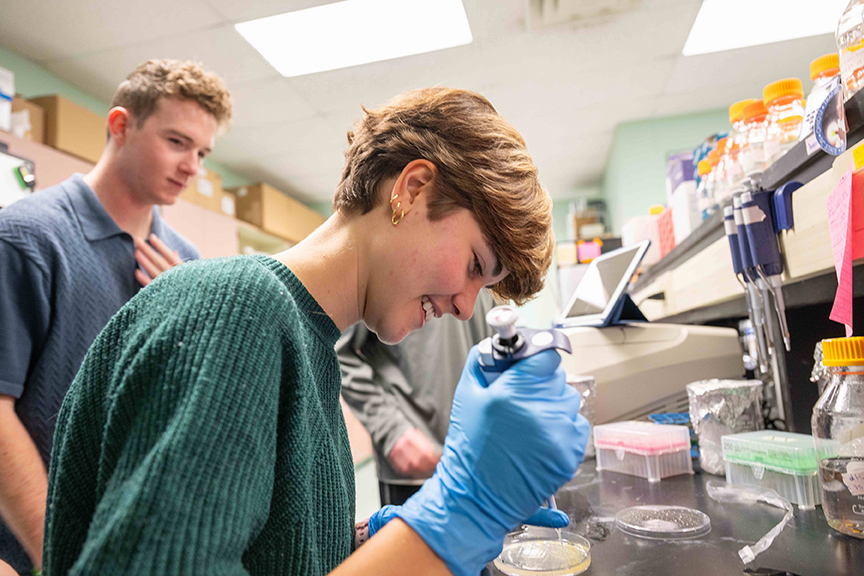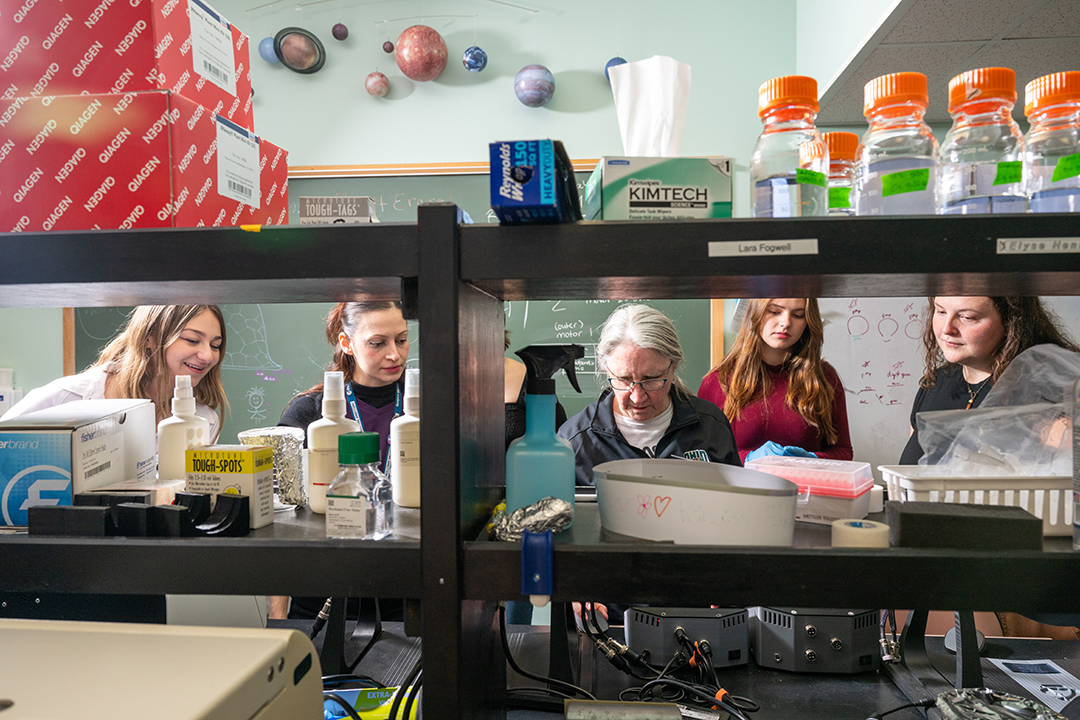On Sarah Wyatt’s 11th birthday, she gazed in wonder at the television in her Mayfield, Kentucky, home as Neil Armstrong and Buzz Aldrin walked on the moon. Nearly 1,000 miles away, fellow 11-year-old Jeffrey Goldstein tuned in from the Bronx, utterly spellbound.
Today, both conduct their own space research while educating future generations of scientists.
As an OHIO professor of plant molecular and cellular biology with a Ph.D. in plant physiology, Wyatt has sent four experiments to the International Space Station—with a fifth departing soon. She studies everything from how microgravity impacts plant growth to the effects of solar radiation on plant development. Wyatt also recently joined 19 top U.S. scientists chosen by the National Academy of Sciences to develop a “ decadal survey ” for NASA, summarizing the past 10 years of national space research and recommending strategies to advance the science over the next 10 years. “Being part of these conversations with top science minds in the country—that was fun,” says Wyatt.
Goldstein also developed his love of space into an education-focused career, earning a Ph.D. in astrophysics and working at such institutions as the Smithsonian and Challenger Center. Today, he directs both the National Center for Earth and Space Science Education (NCESSE) and the Arthur C. Clarke Institute for Space Education .
In 2023, their paths crossed in the form of the Student Spaceflight Experiments Program (SSEP), which Goldstein founded and directs.
Since 2010, SSEP has allowed upper elementary through undergraduate students to design microgravity experiments and write formal proposals; to date, 19 missions have flown student experiments into space. For Mission 18, one winning student experiment from each of the 37 participating learning communities will board an ISS-bound SpaceX shuttle—and for the first time, Ohio University students’ work will be among them.
Collaborations and Communications
Goldstein built the SSEP program to fill a gap in STEM education: the lack of practical collaborations between science education and professional research communities in the U.S.
“There’s one core goal for all of formal education—from pre-K until you get that final diploma and handshake—and that is to prepare our kids for the real world,” Goldstein says. “If we want to inspire students to be scientists and engineers, it's absolutely essential they begin to take on the mantle of scientists and engineers right now. That means asking questions of the world around them, thinking critically, solving problems and working in teams to communicate their thoughts and ideas in person and in writing.”
For SSEP, Goldstein first sends out an announcement to every college, university and public school district in the United States. Every interested community must submit a formal implementation plan demonstrating that they have the appropriate team of educators and a strategy for success. Once accepted, each community gets to send one student-designed experiment to the ISS, eliminating cross-community competition.
Victoria Swiler, a fourth-year environmental and plant biology major from Maumee, Ohio, found out about the SSEP while working in Wyatt’s lab.
“[Dr. Wyatt] was like, ‘Hey, I got this email about a student space research opportunity. Do you want to do this?’ I said, ‘Definitely!’” Swiler recalls. “So she said, ‘OK, you’re helping me with outreach. Let’s draft some emails.’”
Wyatt and Swiler started with about 50 email replies from interested students representing every college on campus. “We heard from students in the sciences and in engineering, but also English majors, history majors, musicians—just everybody,” Wyatt says.
Meanwhile, Michael Lane, a third-year biological sciences major from Hamilton, Ohio, was looking for research opportunities. “When I learned about this, I was like, ‘Space?! Of course I want to do that,’” he recalls.
Lane got placed in OHIO’s “Team 2,” along with Swiler and Nathan Smith, a second-year field ecology major from Centerville, Ohio. The group was facilitated by Nick Whitticar, BS ’17, a Ph.D. candidate in translational biomedical sciences from Strongsville, Ohio.

Pictured: “Team Two" members Nathan Smith, a second-year field ecology major (back), and Victoria Swiler, a fourth-year environmental and plant biology major. Photos by Ben Wirtz Siegel, BSVC '02
Experiment Design
Team 2 joined nine other teams comprising 34 total undergrads for OHIO’s Undergraduate Research and Writing course to learn about the scientific method, proposal writing and the strict parameters of their ISS flight experiments. Wyatt made sure each group involved at least one natural sciences major and otherwise evenly distributed ages and academic backgrounds across the research teams.
According to Goldstein, this approach—and that of the SSEP in general—reflects the interdisciplinary nature of space research. “No discipline is an island,” he says. “If you think about NASA, everybody thinks ‘astronaut.’ But while they’re highly visible—and they deserve to be public heroes—astronauts are essentially glorified technicians. Behind every astronaut are hundreds of engineers and scientists.”
SSEP participants received a crash course in experimental design—including the restrictions involved in research conducted on the ISS, where space is extremely limited and astronaut efforts must be meticulously choreographed in advance.
“Experiments are bound by spaceflight hardware,” Wyatt explains, describing a cylinder that’s 6 inches long and half an inch in diameter, with clips dividing it in halves or thirds. “They can study whatever fits and can remain in stasis [until reaching ISS labs]: plants, bacteria, rust.”
Swiler says that in researching experiment options for their team’s proposal, she reviewed the decadal survey Wyatt collaborated on and found a section about a new bacteria discovered on the International Space Station.
“They sequenced everything and found that [the ISS bacteria] had properties that might enhance plant growth,” Swiler says. “We wanted to see if it really could.”
The student team ordered samples from the NASA Jet Propulsion Laboratory in California, then designed their experiment using seeds of a plant called Arabidopsis (common name: thale cress, a member of the brassica family that’s related to cabbage) embedded in two substrates combining plant food and a gelatin-like solidifying agent called agar—one to use as a control and the other mixed with the ISS bacteria.
“Getting bacteria from the International Space Station was very cool,” Swiler says, “but my favorite part was designing our own experiment.” She explains that, after comparing the control plants with those exposed to the ISS bacteria, the team—led by Smith—will examine the plant samples’ genetic sequencing, looking for specific gene expression.
“I didn’t realize how extensive proposals are,” says Smith, who identified 10 plant genes to analyze in response to the bacteria. “Finding the genes was really fun, but challenging,” he adds. “You have to think about how everything’s going to interact. It’s kind of like a game of chess against myself, where I had to do a lot of research to find the perfect pieces that’ll fit, so we get the right results. One of the genes—the coolest one, I think—lignifies [hardens] cell walls as a pathogenic response.”
After each of the 10 teams finalized their proposals, Roxanne Male-Brune , senior director of grant development and projects in the office of the Vice President of Research, organized a panel of professors to select the three proposals Ohio University would send to NCESSE for final selection.
Team 2 made the cut. Then, in December, the group’s hard work paid off when Executive Vice President and Provost Elizabeth Sayrs announced them as the final winning Bobcat team selected by a committee of experts assembled by NCESSE. Their experiment will fly to the ISS this fall to be conducted by astronauts. Meanwhile, Team 2 will do the same on Earth for additional control data.
The remaining OHIO participants can use Wyatt’s microgravity-simulating clinostat to test their hypotheses in Porter Hall. “Our clinostat has one axis rotating this way and a second axis rotating the other way,” Wyatt explains. “The tubes are still in gravity—they’re in my lab, just rolling—but within the tube, the effects of gravity get confused.”
Applications for All
Wyatt points out that space research on plants, both her own and that of her SSEP student winners, can apply to much more than just space exploration.
“When we learn about growing plants in hazardous conditions—whether we're talking about the moon, Mars or space in general—we also learn to create better ecosystems here on Earth,” Wyatt says. “We have a lot of areas on Earth that are deserts or where the local people experience famine. If we can figure out how to better grow nutritious crops in small, potentially enclosed areas, that can also help people on Earth.”
For Goldstein, the primary goal of SSEP is simply getting young people excited about inquiry-based learning and the scientific method. He believes this approach enriches all students, not only those who pursue STEM studies and careers.
“Humans are born curious, evidence-based learners—asking questions and poking the universe for data,” he says. “The scientific method follows the hands-on, process-based approach that defines how we humans learn best. It’s how scientists and engineers advance their fields, but it’s also how a chef creates a new dish. It's how a poet creates a new work, or an artist puts brush to canvas. The SSEP nurtures those skills through authentic immersion in America’s space program,” Goldstein concludes, adding, “For the record, we are honored and excited to work with Ohio University this year.”
ABOUT THE PROJECT: The Student Spaceflight Experiments Program (SSEP) is a program of the National Center for Earth and Space Science Education (NCESSE) in the U.S. and the Arthur C. Clarke Institute for Space Education internationally. It is enabled through a strategic partnership with Nanoracks, LLC, which is working with NASA under a Space Act Agreement as part of the utilization of the International Space Station as a National Laboratory. Dr. Sarah Wyatt directs the program at Ohio University.




